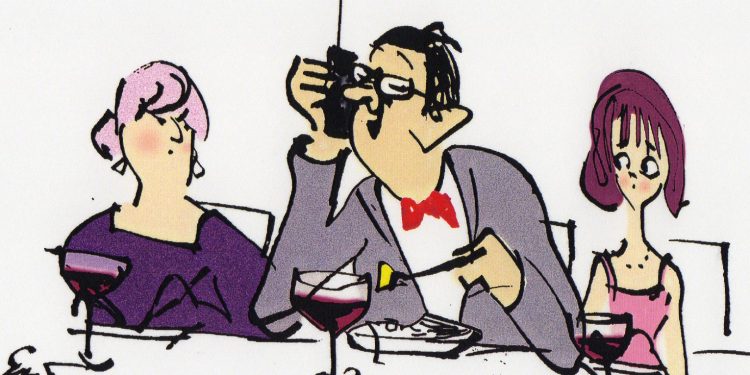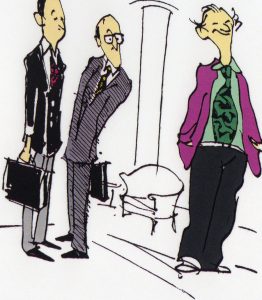Manners and how to behave in a society influenced by the free spirit of the 1960s and 70s

In Denmark, the importance of learning the “dos and don’ts” of how to behave was for many years perceived as something rather controversial, archaic and really old-fashioned. Some say it has changed.
Since the 1970s, old-fashioned things such as how to sit properly at a table, how to hold your fork and knife, dress codes, and learning how to address fellow guests at receptions and dinner parties were not perceived as being important in a Dane’s standard education.
This was all the result of the so-called 1968 generation who had discarded the rules of society and the formal ways of behaving and actually put honour in “misbehaving”.
In the 1990s, several large royal events, the first ones since the Danish Queen’s wedding in 1967, sparked a renewed interest in learning more about “good manners” and how to behave in different social settings.
A modern version of the “Takt and Tone” (which had been published by Emma Gad, a woman who in the 19th century wrote a book about the “proper” way to behave in all kinds of setting and situations) emerged when Inge Correl became the modern icon of good manners (in Danish takt og tone).
For more than 25 years she helped businesses, employees and students ensure that they make a good impression in any social or cultural setting.
The article continues below.
When she started back in the 1990s, Danes had begun to travel more and businesses were expanding internationally. The need to understand how to behave in different social settings and also in other cultural settings was only beginning to be accepted.
She held courses for young managers at Maersk as well as for export and sales personnel at Carlsberg’s international departments and many many other Danish export oriented businesses.
She said in a former interview, that at the time ,she could always tell who was Danish when she attended an international conference or reception.
“I just had to look for the worst dressed group, who had all supplied themselves with ample food and drink and then found a corner to sit and chat with the other Danish participants, most of whom they knew already, rather than mingle and make new acquaintances.”
As her courses were easy targets for ridicule, she used humour in her presentations, trying to make people understand through caricatures and funny drawings.
Below you can find one of them, showing a small group of business people, two of them looking very professional and smart in their attire; the third one with a very dominant tie, a bad haircut and white tennis socks sticking out of trousers that are too short.
“Can you find the Dane?”, she would ask retorically during her courses.
The article continues below.
The attitude towards learning manners and how to behave in different settings all changed with increasing globalisation, the internet and social media and Danes have gained more insight into the importance of understanding how the way they behave may influence other cultures’ perception of them.
So what are “good” manners? Is it all about how to hold a fork and knife we asked Inge Correl in a past interview?
She lauged at the question, she has apparently been asked that question many times.
“No,” she answered. “It’s really about how you behave towards other people, the respect and attention you pay them when you meet socially or in a business context.
And I think that is something Danes at the time (back in the 80s and 90s) didn’t think so much about.
When you are at a business dinner or at a reception, it is a great opportunity to learn more about the people you are dealing with, their country or culture, so why on earth only talk about yourself, your career, the weather, and football?”
In fact, she always taught her students to avoid those four subjects.
What to do instead?
“Ask questions, show an interest in the people you meet, their lives and culture.
You might learn something new and at the same time be able to convey something about your own cultural background for their benefit.”
In her two books with tips and insights she also gives funny examples.
For instance what is the correct time to leave a Danish business dinner party? Do you know?
“Of course it may vary but if it is on a weekday, with a busy working day the next day, guests should leave no later than 23:00. If you do not know the local cultural and social codes it can go quite wrong.
In her book she gives this example:
“A former American ambassador was asked to a dinner party at a manor house on Funen. Arriving there, he told his chauffeur they would be leaving around 22:30. The clock struck midnight but none of the guests were leaving and as time passed, the Ambassador got worried.
He had an important business trip the next day was concerned that he would not be fit for it as the dinner party dragged on into the early morning.
Eventually he discreetly approached the hostess, explaining he was really sorry, but he had to leave, only to be met by the response;“Thank goodness! That is no problem at all. We were all waiting for you to leave – first”.
As he was the most important person there, and the guest of honour, he was expected to leave first (according to Danish etiquette).
The story was related to Inge Correll by the Ambassador who ultimately asked her to teach his embassy staff about the Danish way.
 Inge Correll worked for SAS,Hotel D’Angleterre, the SBM hotels in Monaco (Hotel de Paris, Hermitage) and until 2012, she ran the hotel and conference centre, Havreholm Slot. In 2000, she was awarded the international prize “Leading Woman Entrepreneur of the World”.
Inge Correll worked for SAS,Hotel D’Angleterre, the SBM hotels in Monaco (Hotel de Paris, Hermitage) and until 2012, she ran the hotel and conference centre, Havreholm Slot. In 2000, she was awarded the international prize “Leading Woman Entrepreneur of the World”.
She has retired from the hotel business but is still an active woman.
By Bente D. Knudsen Pictures: Inge Correll and Erik Werner
Support our magazine with a contribution of any size
We do not want to put up a pay-wall, so we need your support and if you find our content relevant and worthwhile, we would value any contribution, however big or small, as a token of your appreciation of our efforts.
How to support:
Transfer any contribution to our bank account at: Your Danish Life/ Danish Expat Media Aps
Danske Bank Account number: 3409 11405673
IBAN: DK68 3000 0011 4056 73
or MobilePay to 2144 1224
Message: Support


